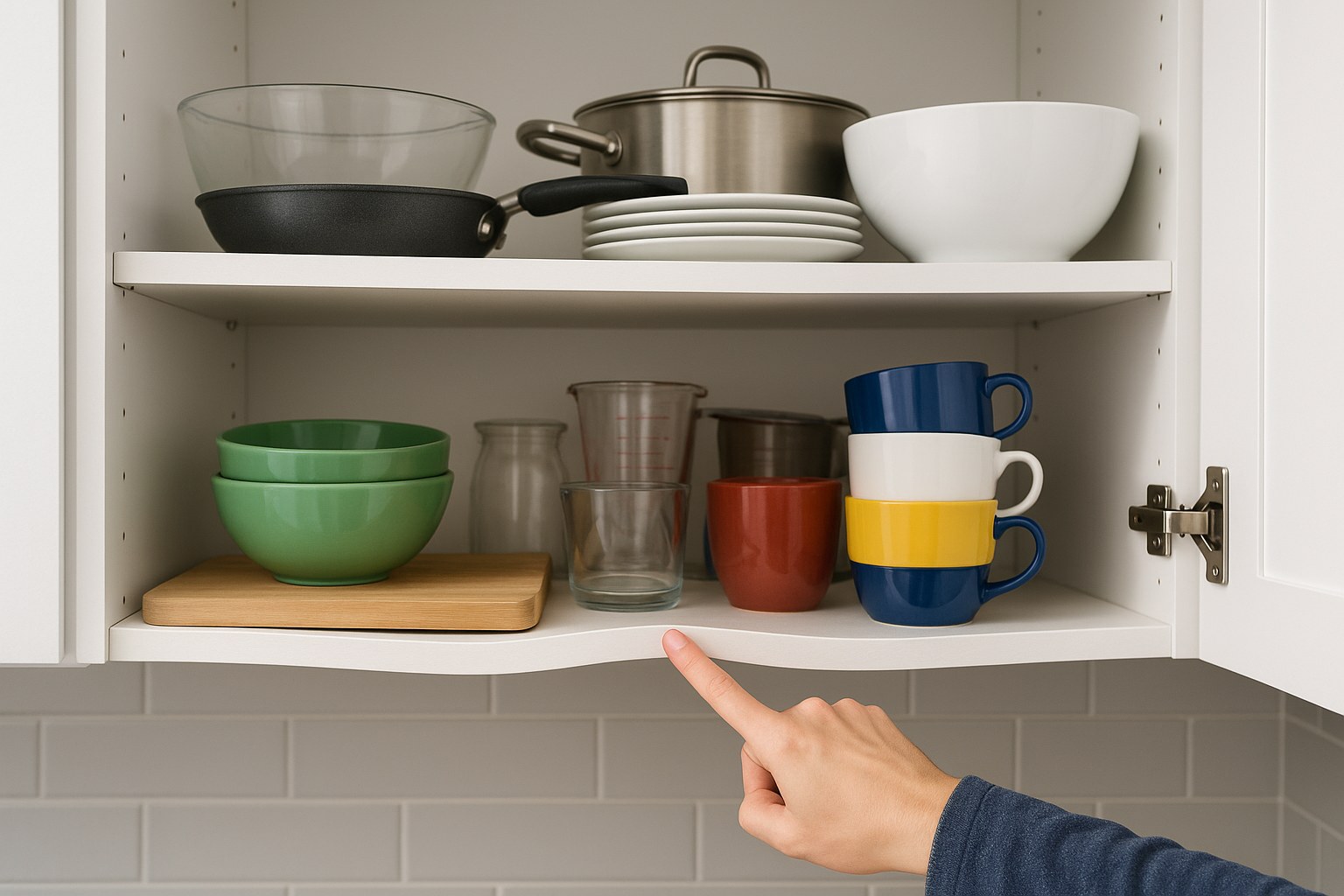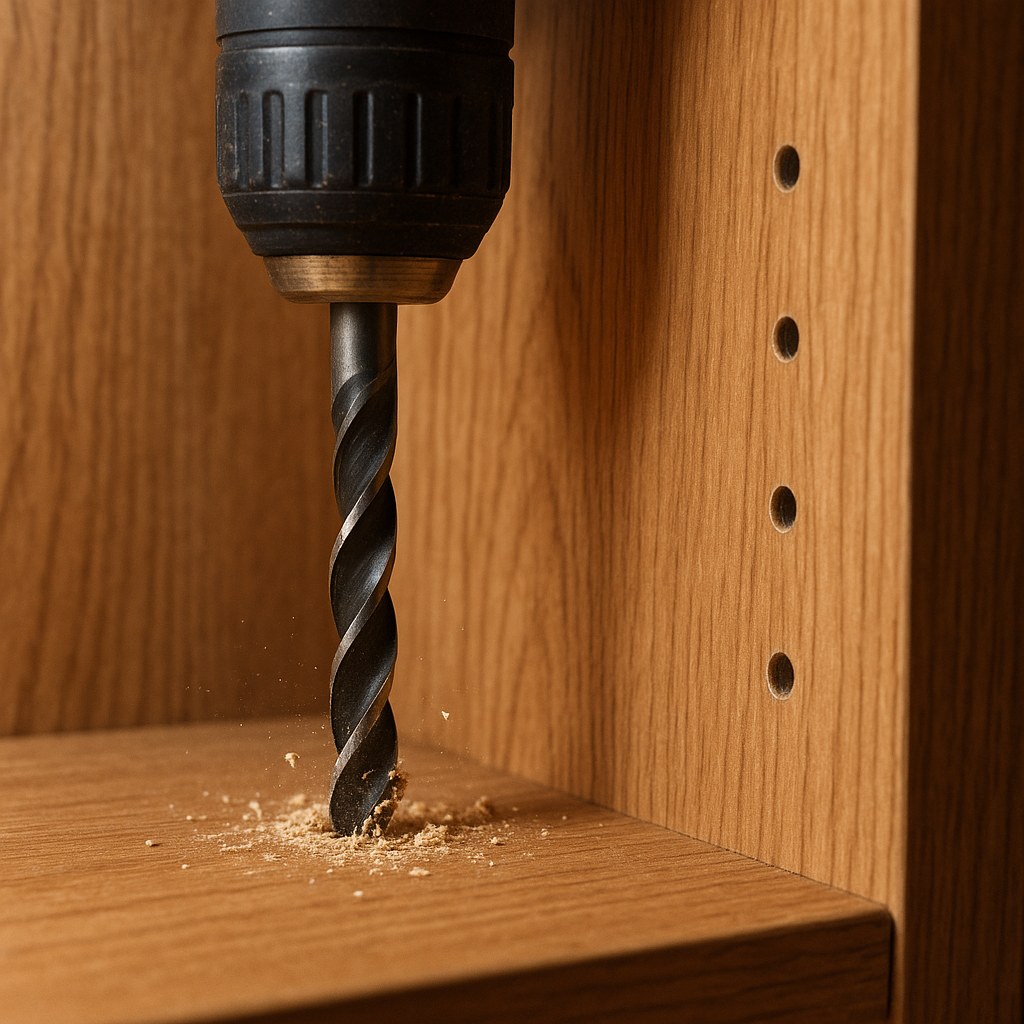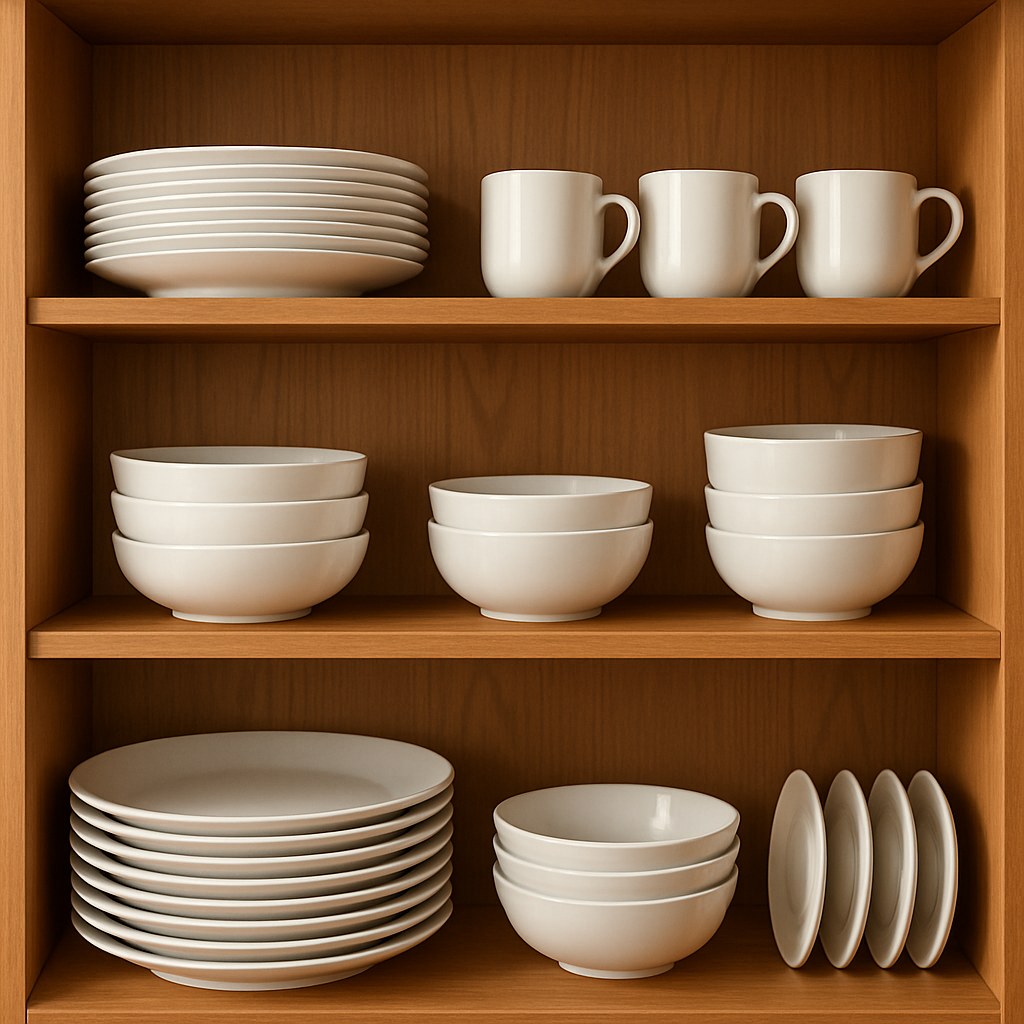It’s a familiar sight for many homeowners: you open a kitchen cabinet or a bookshelf, and you’re greeted by a distinct, unhappy curve. That once-straight shelf is now sagging in the middle, looking like it’s about to give up. A drooping or sagging cabinet shelf isn’t just a cosmetic issue; it’s a sign that the shelf is overloaded, unsupported, or simply not up to the task. If left unchecked, it could eventually break, potentially damaging your dishes, glassware, or other valued items.
The good news is that you don’t have to live with that droop. In most cases, learning how to fix sagging cabinet shelves is a straightforward DIY project that you can tackle in under an hour. With a few basic tools and a little know-how, you can reinforce your shelves and restore them to their former glory.
In this guide, we'll walk you through everything you need to know, from diagnosing the problem to implementing the right fix for your specific type of shelf. Let’s get those shelves straight again!

Why Do Cabinet Shelves Sag in the First Place?
Before we jump into the fix, it helps to understand what causes a shelf to sag. Gravity is the ultimate culprit, but a few specific factors make a shelf more likely to bow.
- Excessive Weight: This is the number one cause. Stacking heavy items like canned goods, cast-iron cookware, or large sets of dishes can place more stress on the shelf than it was designed to handle. A study by the Cabinet Makers Association notes that a standard 36-inch particleboard shelf may begin to sag under as little as 45 pounds.
- Long Span: The longer the distance between supports, the more likely a shelf is to sag in the middle. A shelf that spans more than 24-30 inches without a central bracket is a prime candidate for drooping.
- Inadequate Material: Not all shelf materials are created equal. Particleboard and MDF (Medium-Density Fiberboard) are common in budget-friendly cabinetry but are far more prone to sagging than solid wood or ¾-inch plywood.
- Time and Humidity: Over time, wood and composite materials can slowly creep and deform under a constant load. High humidity can accelerate this process by softening the wood fibers.
Step 1: Your Initial Inspection and Diagnosis
First things first, let's figure out exactly what we're dealing with. This quick inspection will determine the best course of action.
- Empty the Shelf: Carefully remove everything from the sagging shelf and set the items aside. This not only makes it easier to work but also removes the load, allowing you to see the true extent of the sag.
- Assess the Curve: Get down to eye level with the shelf and look along its front edge. You'll likely see a noticeable downward curve or bow.
- Check the Thickness and Material: Is the shelf thinner than the standard ¾ inch? Thinner shelves have less structural integrity. Determine the material. Is it glass? Or is it a wood product like particleboard, plywood, or solid wood?
- Identify the Type: Is the shelf adjustable, resting on small support pins or brackets? Or is it a fixed shelf, built directly into the cabinet structure?
Once you’ve answered these questions, you can move on to the right solution for your shelf.
How to Fix a Sagging Glass Shelf
Glass shelves are common in display cabinets and can add a touch of elegance, but they aren't designed for heavy loads. If your glass shelf is drooping, the fix is usually about load management rather than reinforcement.
- Inspect for Damage: Carefully check the edges and corners of the glass shelf for any chips or cracks. A damaged shelf is a safety hazard and should be replaced.
- Weigh the Contents: If possible, weigh the items you removed from the shelf. As a general rule, a standard glass shelf shouldn't hold more than 15-25 pounds, depending on its thickness and span. If your items weigh more, you've found the problem.
- Reduce and Redistribute: The solution is to reduce the load. Store only your lightest items on the glass shelf and distribute them evenly, placing heavier pieces closer to the support brackets on the sides.
- Test the Flex: After reinstalling the empty shelf, gently press on the center. If it flexes significantly with minimal pressure, it may be too thin for its span.
If the shelf remains sag-free with a lighter load, your problem is solved! If it continues to sag or if you need it to hold more weight, it’s time to call a professional to have a thicker, tempered glass shelf cut to size.
How to Fix a Sagging Wooden Shelf
For wood or composite shelves, you have more hands-on options for a permanent fix. The approach will depend on whether your shelf is adjustable or fixed.
Part A: Fixing an Adjustable Wooden Shelf
Adjustable shelves are convenient, but the pins that hold them up don't provide any support in the middle.
First, remove the empty wood shelf from its support pins or brackets. Place it on a flat surface to confirm the bow. Next, use a measuring tape to measure the distance between the supports inside the cabinet. If that span is more than 24 inches, you've found a key contributor to the sag.
You now have two excellent DIY solutions.
Solution 1: Add a Center Support
The most direct way to fix a bowing shelf is to add support right where it’s needed—in the middle.
Tools You'll Need:
- Measuring tape
- Drill with a ¼-inch drill bit
- Pencil
- Two new metal shelf support pins
Instructions:
- Mark the Midpoint: Measure the span between the existing front and back support pins and mark the exact midpoint on the inside walls of the cabinet.
- Drill the Holes: Using your drill and a ¼-inch bit, drill a shallow hole (about ¼-inch deep) at the marks you made on both sides of the cabinet. A piece of tape on your drill bit can act as a depth guide to prevent drilling all the way through.
- Insert New Pins: Push the new metal shelf support pins firmly into the holes you just drilled.
- Reinstall the Shelf: Place the shelf back into the cabinet, resting it on the original pins plus your new center supports.
- Reload and Admire: You can now place your items back on the newly reinforced shelf. The center support will prevent it from sagging in the future.

Solution 2: Reinforce the Shelf Board Itself
If you can't add center supports, you can add rigidity directly to the shelf board by attaching a "nosing" or "lip" to the front edge.
Tools & Materials:
- Hardwood strip (1-inch by ¾-inch, cut to the length of your shelf)
- Wood glue
- Bar clamps
- Sandpaper
Instructions:
- Apply Glue: With the shelf removed from the cabinet, apply a thin bead of wood glue along the bottom of the front edge.
- Attach the Strip: Press the hardwood strip firmly onto the glued edge. This creates a strong "L" shape that dramatically increases the shelf's resistance to bending.
- Clamp and Dry: Use bar clamps to hold the strip tightly in place while the glue dries. Allow at least 30 minutes, or follow the glue manufacturer's instructions.
- Flip the Shelf: Once the glue is dry, remove the clamps and sand any rough spots. Now for the magic trick: flip the shelf over so the sagging side (the old top) is now facing down. This uses gravity to help straighten the bow over time.
- Reinstall: Place the reinforced shelf back on its support pins. It should now be level, firm, and ready for use.
Part B: Fixing a Fixed Wooden Shelf
Fixed shelves are built into the cabinet, so you can't just flip them over. However, you can still add powerful reinforcement from underneath. First, check if the shelf is overloaded by weighing the items you removed. If they total more than 25-30 pounds, reducing the load is your first step.
Solution: Add a Center Support Cleat
A support cleat is a strip of wood attached to the underside of the shelf, acting as a spine to pull it straight and keep it there.
Tools & Materials:
- 1-inch by 1-inch wood cleat, cut to the depth of the cabinet
- Drill with a pilot bit
- 1¼-inch wood screws
Instructions:
- Position the Cleat: Hold the wood cleat against the underside of the fixed shelf, running it from front to back down the center.
- Pre-Drill Holes: While holding the cleat firmly, pre-drill three evenly spaced pilot holes through the cleat and slightly into the shelf. Pre-drilling prevents the wood from splitting.
- Secure the Cleat: Drive three 1¼-inch wood screws through the cleat into the shelf. As you tighten the screws, they will pull the sagging center of the shelf upward, straightening it out.
- Reload Carefully: Wipe away any sawdust and put your items back, making sure to keep the heaviest things off the shelf to prevent future issues.

When Is It Time to Call a Professional?
While these DIY fixes cover most situations, there are times when it’s best to call in a handyman or carpenter. If you've tried these solutions and the shelf still sags, or if you encounter any of the following, it might be time for expert help:
- The cabinet walls themselves are bowing or feel weak.
- You need to replace the shelf entirely with a stronger material like ¾-inch plywood.
- The shelf is made of a unique material or has a complex design.
- You’re simply not comfortable using power tools for the repair.
Hiring a handyman for this type of job typically costs between $75 and $150, and they can often complete the work in under an hour.
Your Home Maintenance Partner
Fixing a sagging cabinet shelf is a satisfying project that improves both the function and appearance of your home. By correctly identifying the cause and applying the right reinforcement technique, you can ensure your shelves stay straight and strong for years to come.
For more easy-to-follow guides, home maintenance reminders, and instant access to trusted local professionals for the jobs you can't handle alone, download the Casa app today! Casa is designed to empower homeowners, making it simple to manage, maintain, and love your home.


